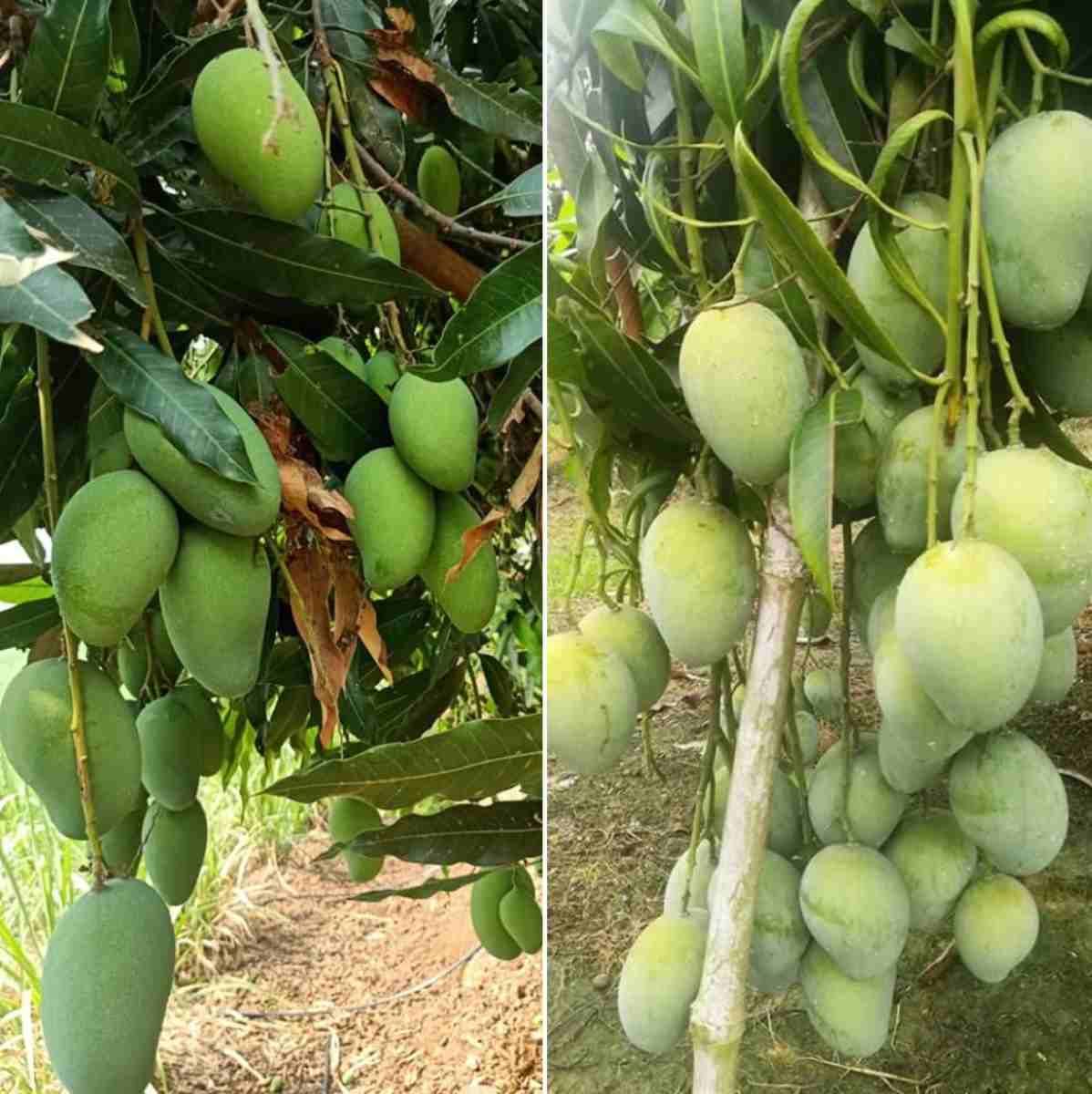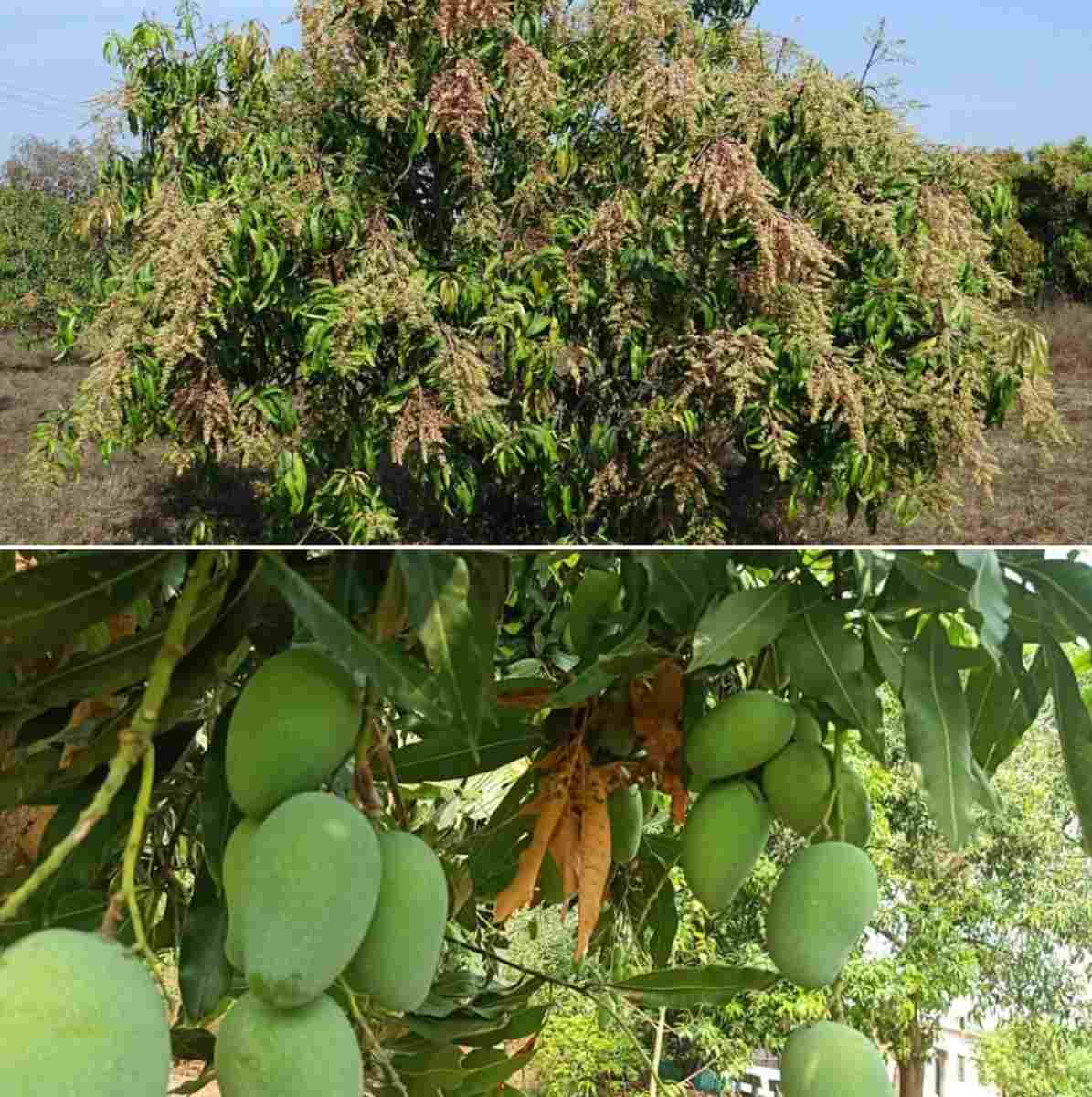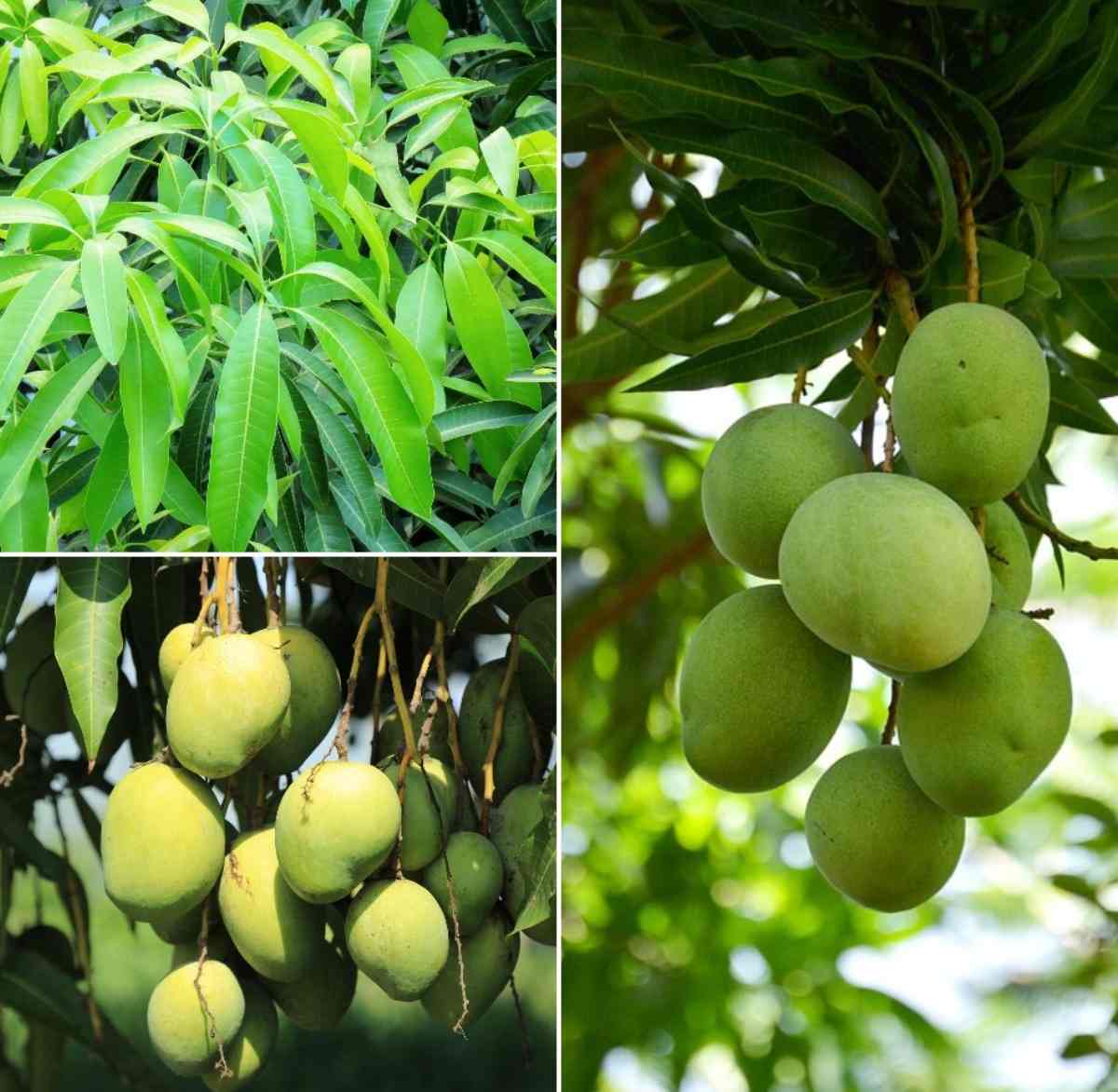Introduction to Mango pests and diseases
The Mango belongs to the family of Anacardiaceae, which is one of the most important tropical and subtropical fruits of the world. It is called the king of fruits on account of its nutritive value, attractive fragrance, taste, and health-promoting qualities.
A step by step guide to Mango pests, diseases, and their control
It is one of the most delicious fruits grown in India. India alone accounts for nearly 80 percent of the world’s mango production. A substantial quantity is being exported to different parts of the world. Caring for Mango trees must include watching for pests and diseases. Deal with these pests and diseases as they occur with organic pesticides, cultural and biological controls, or horticultural oils.

Mango pests and their control
Hopper pests of the Mango tree
Of all the Mango pests, hoppers are mainly considered as the most serious and widespread pest throughout the country. A large number of nymphs and adult insects puncture and suck the sap of tender parts, thereby reducing the vigor of the Mango plants. Heavy puncturing and also continuous draining of the sap causes curling and drying of the infected tissue.
Control – Three sprays of about 0.15% Carbaryl or 0.04% Monocrotophos or 0.05% Phosphamidon or 0.05% Methyl Parathion are effective in controlling the hoppers. The first spray must be given at the early stage of panicle formation. The second spray at the full-length stage of panicles but before full bloom and then, the third spray after the fruits set at the pea-size stage is recommended. Biological control agents such as the predators Mallada boninensis and Chrysopa lacciperda, and preparation of the fungus Beauveria bassiana are very important and useful in controlling this pest.
Mealy Bugs pests of Mango trees
Nymphs and adults suck the plant sap and reduce the vigor of the Mango plant. Excessive and continuous draining of Mango plant sap causes wilting and finally drying of infected tissue. They secrete honeydew, a sticky substance, which facilitates the development of the fungus Maliola mangiferae. After climbing up the Mango tree, they start sucking the sap of tender plant parts. They are considered important because they infest the crop during the flowering season.
Control – Flooding of orchards with water in October kills the eggs and plowing the orchards in November exposes the eggs to the sun’s heat. Polythene bands of 400 gauge and 25 cm width fastened around the tree trunk have been found the effective barrier to stop the ascent of nymphs to the Mango trees. The band must be fastened well in advance before the hatching of eggs, i.e., during November- December. Spraying of about 0.05% Monocrotophos or 0.2% Carbaryl or 0.05% Methyl Parathion is useful in controlling young nymphs of the mealybug.
Inflorescence Midge
The midge infests and damages the Mango crop in three different stages. The mature larvae create small exit holes in the axis of the inflorescence and slip down into the soil for pupation. When the tender fruits are attacked they slowly turn a yellow color and finally drop. The third attack is on tender new plant leaves encircling the inflorescence. The damaging one is the first attack in which the entire inflorescence is destroyed even before flowering and fruiting. Then, the inflorescence shows stunted growth and its axis bends at the entrance point of the larvae.
Control – Soil application of Heptachlor or Methyl Parathion at 25 to 30 kg/ha kills pupating larvae in the soil. Spraying of 0.05% Fenetrothion or 0.045% Dimethoate at the bud burst stage of the inflorescence is more effective.
Fruit fly pests of Mango
The oriental fruit fly is one of the serious pests of Mango in the country, which has created problems in the export of fresh fruits. The emergence of fruit fly starts from April onwards and the maximum population is recorded during May- July, which coincides with Mango fruit maturity. The population declines very slowly from August to September after that it is non-existent up to March.
Control – To control his pest, Bait sprays of Carbaryl (0.2%), and protein hydrolysate (0.1%) or hanging traps containing 100 ml water emulsion of Methyl Euginol (0.1%) and Malathion (0.1%) during fruiting is more effective.
Shoot Borer pests of Mango plants
This pest is found all over the country and larvae of this moth bore into the young shoot resulting in dropping of leaves and wilting of shoots. Larvae bore into the inflorescence stalk. Female moths lay eggs on tender plant leaves. After hatching, young larvae enter the midrib of plant leaves and then enter into young shoots through the growing points by tunneling downwards.
Control – The attacked shoots can be clipped off and destroyed. Then, spraying of Carbaryl (0.2%) or Quinalphos (0.5%) at fortnightly intervals from the commencement of new flush gives effective control of the pest. A total of 2 to 3 sprays can be given depending on the intensity of infestation.
Bark Eating Caterpillar pests of Mango trees
The old, shady, and neglected orchards are more prone to attack by this caterpillar pest. Larvae of this moth feed on the bark and weaken the Mango tree. A single female lays about 300 to 400 eggs in batches on the bark. The caterpillar spins brown silken web on the Mango tree, which consists of their excreta and wood particles. Larvae make shelter tunnels inside the stem in which they rest. Larvae normally feed from April to December.
Control – To control this pest, removal of the webs from tree trunks and injecting emulsion of Monocrotophos about 0.05% in each hole and plugging them with mud can control the caterpillar pest.
Bark Cracking pests of Mango trees
Symptoms
- The malady manifests as longitudinal cracks on trunk and limbs.
- Bark dries in an advanced stage.
- The leaves in the affected tree are spares, pale, and lusterless.
- The tree exhibits wilting symptoms and after some time the entire tree dries up.
- Most conspicuous symptoms are rotting of roots and adherence of dried leaves to twig.
Control – One spray with copper oxychloride about 3g/liter or application of 250 g copper sulfate per three basins will contain the malady to a great extent.
Stem Borer
It is a major pest in the Mango tree. The grub is damaging stage and damages by cutting and chewing of new twigs and also shoots. Once grub enters in the shoot creates tunnel inside the stem and then damages the stem resulting in drying of shoots. Eggs are laid either in the slits of a tree trunk or in the cavities in main branches and also stems covered with a viscous fluid. Pupation takes place within the stem and beetle emerges in July-August.
Control – To control this pest, cleaning the tunnel with hard wire, creosote, petrol, crude oil and subsequently closing the entrance of the tunnel with mud or plugging it with cotton wool soaked with the above substances kills the grub.
Shoot Gall Psylla
It is a serious pest of Mango in many parts of India. This pest makes green conical galls in the leaf axis. The activity of the pest starts from August and the galls dry out after the emergence of adults in March. The adult females lay eggs in the midribs as well as in the lateral axis of new plant leaves. Nymphs emerge from eggs during August-September and then crawl to the adjacent buds to suck cell sap. As a result of feeding, then the buds develop into hard conical green galls. The galls are seen during September-October. Consequently, there is no fruit set.
Control – The galls with nymphs inside must be collected and destroyed to prevent the carryover of the pest. Then, the pest can effectively be controlled by spraying of Monocrotophos (0.05%), Parathion (0.04%), Metasystox (0.1%) at 2-week intervals starting from the middle of August. Repeated use of the same chemical for every spray must be avoided.
Leaf Webber
The infestation starts in April and continues up to December. Eggs are laid singly or in clusters within silken webbings on plant leaves. Upon hatching, the caterpillars feed on the surface of the leaf by scrapping. Later, they create a web on tender shoots and leaves together and feed within. Old orchards with lesser space between Mango tree canopies have more infestation than open orchards.
Control – Pruning of infested shoots and their burning in April to July is found very effective. Then, raking of the soil around the base of the trees in January, after the last generation has pupated, helps in checking the pest population. The sprays starting from the last week of July at 15 days interval with Carbaryl (0.2%) or Monocrotophos (0.05%) or Quinalphos (0.05%) effectively controls the pest.
Stone Weevil
Stone weevil is a common pest of Mango in southern India. Then, newly emerged grubs bore through the pulp, feed on the seed coat, and later cause damage to cotyledons. Pupation takes place inside the seed and pulp is discolored around the affected portion.
Control – The pest population can be kept under check by destroying the affected Mango fruits and exposing the hibernating weevils by digging the soil. Spraying the Mango trees with Fenthion (0.01%) is found effective.
Mango tree diseases and their control
In case if you miss this: Hydroponic Drip System, Types, Advantages.

Mango tree suffers from several diseases at all stages of its life. All the parts of the Mango plant, namely, trunk, branch, twig, leaf, petiole, flower, and fruit are attacked by several pathogens including fungi, bacteria, and algae. Then, they cause several kinds of rot, dieback, anthracnose, scab, necrosis, blotch, spots, mildew, etc. Some of the diseases like powdery mildew are of great economic importance as they cause heavy losses in Mango production. Major diseases of Mango and their control measures are given below;
Anthracnose
The anthracnose disease in Mango is of widespread occurrence and the disease causes serious losses to young shoots, flowers, and fruits. It also affects fruits during storage. The disease produces leaf spots; blossom blight, twig blight, and fruit rot symptoms. Tender shoots and foliage are affected which ultimately cause “die back” of young branches. Older twigs may be infected through wounds which in severe cases may be fatal.
Control – Trees can be sprayed twice with Bavistin (0.1%) at 15 days interval during flowering to control blossom infection. Spraying of copper fungicides about 0.3% is recommended for the control of foliar infection.
Sooty mold
The sooty mold disease is common in the orchards where mealybug, scale insect, and hopper are not controlled efficiently. In severe cases, the Mango trees turn completely black due to the presence of mold over the entire surface of twigs and leaves. The severity of infection mainly depends on the honeydew secretion by the above-said insects. Honeydew secretions from insects stick to the leaf surface and give the necessary medium for fungal growth. The fungus is saprophytic and is non-pathogenic because it does not derive nutrients from the host tissues. Though no direct damage is caused by the fungus, the photosynthetic activity of the leaf is adversely affected due to the blockage of stomata.
Control – Pruning of affected branches and their prompt destruction prevents the spread of this disease. Then, spraying of 2 percent starch is found effective.
Black Rot
Black rot is a post-harvest disease and caused by Aspergillus niger Van Tiegh. Affected fruits show yellowing with irregular grayish color spots, which develops into a black necrotic area with the growth of black mold. The black rot disease can be managed by avoidance of injury to Mango fruits and its contact to soil, dipping of fruits in hot water with Carbendazim (0.5%) for 5 minutes and covering of fruits with brown or newspaper bags on the tree itself 15 days before harvest.
Powdery mildew
It appears as spots or patches of white to grayish, powdery growth (mycelium) on the surface of leaves and other plant parts. The mycelium is most visible on the upper leaf surface, covering it completely as the disease progresses. Damage from powdery mildew can take some time to develop. Severe outbreaks could cause defoliation, exposing the fruit to sunburn and predisposing them to secondary rots.
Control options for powdery mildew
- Use suitable cultural management procedures, including removal of diseased twigs and crop debris, to reduce inoculums levels.
- Apply pre-infection and post-infection fungicides.
- Plant resistant varieties when appropriate, and available.
Stem end rot
Symptoms – A dark rot develops from the stem end as the fruit ripens after fruit harvest. And a dark brown to black rot begins at the stem end as a dark brown ring and the rot proceeds towards the other end. Then, the rot produces dark streaking of the water-conducting tissues.
Control options
- Water stress during fruit development can predispose fruit to infection, manage irrigation, and root rot control carefully. Pre-harvest sprays of fungicides to control bacterial black spot or anthracnose can reduce the incidence of stem-end rot in fruit. Prune trees to improve ventilation and spray
- Avoid harvesting immature fruit and cool fruit immediately after harvest and store in well-ventilated containers.
Die Back
It is one of the serious diseases of Mango. The disease on the tree can be noticed at any time of the year but it is most conspicuous during October-November. The disease is characterized by drying of twigs and branches followed by complete defoliation, which gives the Mango tree an appearance of scorching by fire. Initially, it is evident by discoloration and then darkening of the bark. The dark area advances and extends outward along the veins of plant leaves. The affected leaf turns brown color and its margins roll upwards. This can be accompanied by the exudation of yellowish-brown gum.
Control – Pruning of the diseased twigs 2 to 3 inches below the affected portion and spraying Copper Oxychloride (0.3%) on infected trees controls the disease. The cut ends of the pruned twigs are pasted with Copper Oxychloride about 0.3%.
Red Rust
The disease attack causes reduction in photosynthetic activity and defoliation of plant leaves thereby reducing the vitality of the host plant. The disease is evident by the rusty red spots on leaves and sometimes on petioles and bark of young twigs. The spots are greenish grey and velvety in texture. Then, they turn reddish-brown. Then, the affected portion of stem cracks.
Control – Two to three sprays of Copper Oxychloride (0.3%) is effective in controlling the red rust disease.
Commonly asked questions about Mango cultivation
You should not miss this: Biofloc Shrimp Farming.

What is the lifespan of the mango tree?
Mango tree life span is about 100-200 years. And it can grow up to 40metres in height.
How much time does it take to grow a mango tree?
The Mango seed grown trees will take a lot longer to bear fruit. Mango trees that were grown in a nursery are grafted and should fruit within three to four years. Seedling trees may take 5 to 8 years.
Why do Mango trees flower but not set fruit?
Poor Mango fruit set can be caused by poor pollination due to cold weather at flowering or fungal diseases, such as anthracnose in the flowers.
How much water does a mango tree need?
Mango trees need to be watered throughout the first 2 years of their life to supplement rainfall and encourage growth. Each Mango tree needs about 26 gallons of water per week.
Why are the leaves on mango trees turning brown?
Leaves turn brown for several reasons but the main cause is the disease anthracnose. If mainly the tips of the Mango leaves are turning brown, it is probably fertilizer burn or saline irrigation water.
Why is Mango fruit splitting?
The main reason for Mango fruit splitting is an infection by bacterial black spot.
Why is Mango fruit dropping off?
Mango flowers will set much more fruit than the tree can hold and have significant Mango fruit drop. Other reasons for Mango fruit falling off include water stress, poor pollination, disease, and insect attack.
The conclusion of Mango pests and diseases
If you are a commercial mango farmer, you must be aware of these major pests and diseases and their control methods to prevent any damage to the crop. In case if you are interested in: How to Make Money from Organic Farming Business.
Quite informative.
mango malformation disease control methods and suggest pesticide in the market